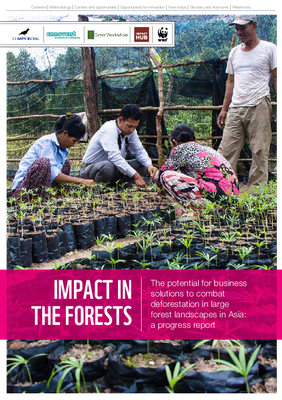Impact in the Forest: The Potential for Business Solutions to Combat Deforestation in Large Forest Landscapes in Asia

Author(s): Nigel Dudley, Paul Chatterton, Elisabeth Cramer, Alberto Cremonesi, Raphaele Deau, Tanja Havemann, Holger Hoffmann-Riem, Tapas Neupane, Agnes Safford, Peter Scheuch, Deepak Shandilya, Petr Skvaril, Sue Stolton, Sandeep Varma
Publication Date: 2016
DOWNLOAD FILE
Key points in document
- The four collaborators on the report, WWF, Ennovent, the Impact Hub, and Clarmondial, bring perspectives from the environment, businesses innovation, development of local entrepreneurial ecosystems and financing for sustainable development, respectively.
- The document discusses environmental, social, and political conditions in Asia, particularly Vietnam, Indonesia, and Nepal. It then explores the relationship between these conditions and enterprises addressing deforestation.
- Eight findings identified as “key:” (1) there are higher incentives for promoting deforestation than preventing it; (2) opportunities exist for forest-based enterprises that reduce deforestation, but incentives must be improved; (3) there are opportunities to scale-up businesses to have a larger, landscape level impact on the environment; (4) linking smaller businesses with investors and larger companies will improve market links and help scale-up enterprises; (5) Asia in particular lacks some of these links, and a combination of innovators, incubators, connectors, and investors are the best relationships for small businesses to scale-up; (6) public sector investments for reducing emissions (etc.) have increased, but smaller enterprises likely do not have access to these funds; (7) clearer standards and monitoring systems are required to make clear what a “green” enterprise is, which will make private sector investment will be easier to achieve; and (8) forest-friendly businesses are relatively new, and an evidence base must be built to foster a learning environment around the practice.
Information relevant to Learning Questions:
Are enabling conditions in place to support a sustainable enterprise?
- Stakeholder alignment
- Market demand, profit potential, access to credit/capital
- Government requirements, policies for enterprises, business alliances
- Financial management capacity, technical capacity
- Infrastructure
- Benefit sharing, targeted participants, combined strategic approaches, biodiversity linkage, policies for and enforcement of resource use
Does the enterprise lead to benefits to stakeholders?
- Increased income for participants
- Non-cash benefits
Do the benefits lead to positive changes in attitudes and behavior?
- Not addressed
Does a change in stakeholders’ behaviors lead to a reduction to threats to biodiversity (or restoration)?
- Residential and commercial development
- Agriculture and aquaculture
- Energy production and mining
- Transportation and service corridors
- Biological resource use
- Human intrusions and disturbance
- Natural system modifications
- Invasive and other problematic species and genes
- Pollution
- Geological events
- Climate change and severe weather
Does a reduction in threats (or restoration) lead to conservation?
- Forest ecosystems
- Freshwater ecosystems
- Grassland ecosystems
- Species

